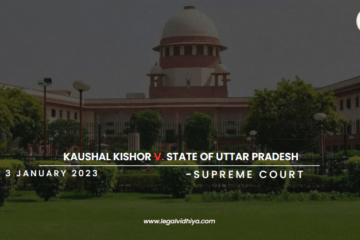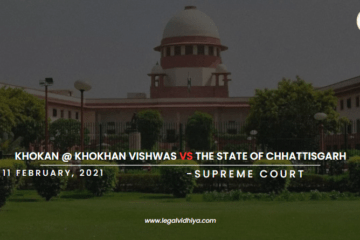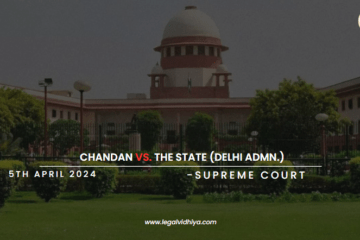
| CITATION | Civil Appeal No(s). 4092-4093/2024 arising out of SLP (C) No(s). 6370-6371/2024 arising out of SLP (C) Diary No. 32072 /2021 |
| DATE OF JUDGEMENT | March 12, 2024 |
| COURT | Supreme Court of India |
| APPELLANT | Mahanadi Coalfields Ltd. (MCL). |
| RESPONDENT | Brajrajnagar Coal Mines Workers’ Union |
| BENCH | Justice Pamidighantam Sri Narasimha, J.Justice Sandeep Mehta, J. |
INTRODUCTION
The case of Mahanadi Coalfields Ltd. (MCL) vs. Brajrajnagar Coal Mines Workers’ Union (the Union) hinges on the dispute of regularisation for contractual workers in India’s coal industry. It centres around 32 workers who were engaged through a contractor by MCL between 1984 and 1994 to perform tasks related to coal transportation. After a decade of service, the Union sought permanent employment status for these workers.
Following negotiations, a settlement was reached where 19 workers were regularised by MCL. The remaining 13 workers were denied permanent status. This decision by MCL sparked the legal battle, with the Union contesting the exclusion of these 13 workers. The core argument of the Union rested on the claim that the nature of the work performed by all 32 workers was essentially the same. They challenged MCL’s decision to deny regularisation for the remaining 13 as discriminatory and unjustified.
The legal journey began with attempts at conciliation and progressed through the Industrial Tribunal system. The Tribunal ultimately ruled in favour of the Union, directing the regularisation of the remaining 13 workers. MCL appealed this decision to the High Court, which upheld the Tribunal’s verdict. Unwilling to accept defeat, MCL then approached the Supreme Court of India, seeking to overturn the lower court rulings.
This case brings to light crucial aspects of India’s labour laws, particularly those concerning contract labour and the right to permanent employment. The Court’s decision will have a significant impact on the lives of these 13 workers and potentially set a precedent for similar cases involving contractual workers in India.
FACTS OF THE CASE
- This case involved a dispute over the regularisation of contract workers in the coal mining industry of India.
- A total of 32 workers were engaged by Mahanadi Coalfields Ltd. (MCL) through a contractor from 1984 to 1994.
- These workers were involved in tasks related to coal transportation, which presumably included activities like loading, unloading, and handling coal.
- In 1994, the Brajrajnagar Coal Mines Workers’ Union (the Union) advocated for permanent employment status for all 32 workers. Negotiations between the Union and MCL resulted in a settlement reached in 1997. This settlement acknowledged the Union’s claim for the 32 workers but differentiated between their job categories.
- Nineteen (19) workers were deemed to be performing tasks considered “permanent and perennial” in nature. MCL agreed to regularise these 19 workers.
- The settlement mentioned that the remaining workers were involved in “purely casual nature of jobs” and were not eligible for regularisation according to MCL.
- The Union contested MCL’s classification of the remaining 13 workers’ jobs as casual. They argued that the nature of work performed by all 32 workers was similar and essential for MCL’s coal transportation operations. The Union believed the denial of regularisation for the remaining 13 workers was arbitrary and unjustified.
- Given the disagreement over regularisation, the case was referred to the Industrial Tribunal system. The Tribunal examined witness statements, including those from MCL’s management personnel. Notably, some of MCL’s own witnesses acknowledged that the tasks performed by all 32 workers, including the 13 in question, were regular and ongoing (perennial) in nature. Based on the evidence presented, the Tribunal ruled in favour of the Union. The Tribunal directed MCL to regularise the remaining 13 workers, recognizing their work as being no different from the 19 workers who were already regularised.
- MCL challenged the Tribunal’s decision by appealing to the High Court.
- The High Court upheld the Tribunal’s verdict, siding with the Union’s argument that the nature of work justified regularisation for all 32 workers. MCL, still unwilling to accept the decision, appealed to the Supreme Court of India.
ISSUES RAISED
- Was the work performed by the 13 workers “permanent and perennial” in nature, as defined by the National Coal Wage Agreement (NCWA-IV)?
- Did the Industrial Tribunal have the authority to revisit the issue of regularisation for the 13 workers after the initial settlement was reached?
- Who has the burden of proof in determining the nature of the work performed by the 13 workers?
- Should the 13 workers be awarded back wages if they are regularised?
CONTENTIONS OF APPEALENT
- MCL would likely argue that a clear distinction existed between the tasks performed by the 13 workers and the 19 who were regularised. They might present: Job descriptions highlighting the difference in duties. Witness statements from supervisors or managers differentiating the work nature.
- Their aim would be to prove that the 13 workers’ tasks weren’t “permanent and perennial” as defined by the National Coal Wage Agreement (NCWA-IV). This could involve arguing: The tasks were temporary or seasonal. The workers weren’t consistently employed throughout the year.
- MCL might contend that the 1997 settlement was a final and binding agreement between both parties under the Industrial Disputes Act. They would argue that: The Union had an opportunity to raise concerns about all 32 workers during the negotiations. Accepting the settlement for 19 workers precluded them from reopening the issue of regularisation for the remaining 13.
- MCL could argue that the onus was on the 13 workers to prove their work qualified for regularisation. They might present: Records indicating the workers weren’t employed continuously. Any evidence suggesting the tasks were not core or essential to MCL’s operations.
- MCL might highlight the financial burden of regularising the 13 workers, particularly regarding back wages. They could argue: The delay in challenging the settlement after it was reached made awarding back wages unreasonable. Regularising them would create an unexpected financial strain.
- MCL would likely contest the Union’s argument that all 32 workers performed similar tasks. They might present: Witness statements from management personnel supporting their classification of the work. Any evidence suggesting a clear distinction in the nature and duration of tasks performed by the two groups.
CONTENTIONS OF RESPONDENT
- The Union would likely argue that all 32 workers, including the 13 in question, performed tasks that were essentially the same and essential for MCL’s coal transportation operations. They might present: Witness statements from workers highlighting the similarity of tasks. Evidence suggesting the work was ongoing and repetitive throughout the year.
- The Union could challenge MCL’s classification of the 13 workers’ tasks as “purely casual.” They might argue that: The NCWA-IV definition of “permanent and perennial” applies to the work performed by all 32 workers. MCL’s classification aimed to deny these workers the benefits of regularisation associated with permanent jobs.
- The Union might argue that the initial settlement only addressed the readily-identifiable “permanent and perennial” tasks performed by the 19 workers who were regularised. They could contend that: The settlement wasn’t intended to preclude further examination of the remaining workers’ job nature. The Tribunal had the authority to assess the nature of work for all 32 workers based on evidence presented.
- The Union might counter MCL’s argument about the burden of proof by stating that: MCL, as the employer, had the responsibility to clearly define job roles and differentiate between the tasks performed by the two groups. Evidence already presented, including statements from MCL’s own management, established the ongoing nature of the work performed by all 32 workers.
- The Union would likely argue that regularising the 13 workers was not only justified but also legally mandated under the NCWA-IV. They might contend that: Denial of regularisation for these workers, despite the nature of their work, was discriminatory and unfair. Since the work performed was eligible for regularisation benefits, back wages should be awarded to compensate for the delay in recognizing their permanent employee status.
JUDGEMENT
The Supreme Court of India delivered a landmark judgement in favour of 13 coal mine workers who had been denied permanent status by Mahanadi Coalfields Ltd. (MCL). This case involved a group of 32 workers who started working for MCL in 1984 through a contractor. In 1994, the Brajrajnagar Coal Mines Workers’ Union sought permanent employment for all 32 workers. A settlement was reached in 1997, but it only regularised 19 workers. MCL argued that the remaining 13 workers held casual positions. However, the Industrial Tribunal disagreed. After examining the nature of the work performed, the Tribunal ruled that all 32 workers deserved permanent status, highlighting that the 13 excluded workers performed duties similar to the regularised ones. The High Court upheld this decision. Finally, the Supreme Court concurred, finding MCL’s denial of permanent status to the 13 workers unjustified and discriminatory. This judgement emphasises the importance of fair treatment for contract workers and ensures that those performing perennial tasks are rightfully classified as permanent employees. The court’s decision required MCL to not only regularise the 13 workers but also award them backdated wages from 2002, signifying a significant victory for the workers’ union and a reminder to companies to adhere to labour regulations.
ANALYSIS
The case of Mahanadi Coalfields Ltd. (MCL) vs. Brajrajnagar Coal Mines Workers’ Union brings to light critical issues surrounding contract labour, worker rights, and the interpretation of labour agreements in India’s coal industry. This legal battle centres on the fate of 13 workers who were denied permanent employment status (regularisation) despite performing tasks similar to a group of 19 workers who were regularised.
A core question revolves around the classification of work performed by these 13 workers. The National Coal Wage Agreement (NCWA-IV) discourages employing contract labour for “permanent and perennial” jobs. The crux of the dispute lies in determining whether the tasks performed by all 32 workers fall under this category as defined by the agreement.
The case raises several points for analysis. Firstly, the validity of the initial settlement reached between MCL and the Union is debatable. MCL might argue that the settlement addressed all regularisation concerns, while the Union could counter that it only addressed the readily identifiable permanent tasks of the 19 regularised workers. The Supreme Court’s decision on the Industrial Tribunal’s authority to revisit the issue will be crucial.
Secondly, the burden of proof regarding the nature of work performed by the 13 workers is another point of contention. MCL might argue that the onus lies with the workers to prove their tasks were “permanent and perennial.” The Union could counter that the evidence already presented, including statements from MCL’s own management, establishes the ongoing nature of the work performed by all 32 workers.
The potential impact of the Supreme Court’s verdict extends beyond this specific case. A ruling in favour of the Union, directing regularisation for the remaining workers, would set a precedent for ensuring contract workers performing core, ongoing tasks receive benefits associated with permanent employment. This could lead to a more stable and motivated workforce in the industry. It could encourage clearer classifications of contract labour to prevent exploitation. A verdict upholding MCL’s decision could leave the 13 workers in a precarious position with limited job security and benefits. It might discourage contract workers from challenging their employment status.
The Mahanadi Coalfields case has far-reaching implications for contract labour practices in India. The Supreme Court’s judgement will be keenly awaited, as it has the potential to influence worker rights, labour classifications, and the overall treatment of contract labour within the coal industry and beyond.
CONCLUSION
The Supreme Court’s judgement in Mahanadi Coalfields Ltd. (MCL) vs. Brajrajnagar Coal Mines Workers’ Union is a landmark case that highlights the rights of contract workers in India. The case centred around the denial of permanent status to 13 workers despite them performing similar tasks to regular employees. The Court’s decision not only required MCL to regularise these workers but also awarded them backdated wages, setting a precedent for ensuring fair treatment of contract workers and proper classification of job roles. This judgement has far-reaching implications for the coal industry and beyond, potentially leading to a more stable workforce and adherence to labour regulations.
REFERENCES
- https://www.advocatekhoj.com/library/judgments/announcement.php?WID=17362
- https://www.the-laws.com/encyclopedia/browse/case?caseId=004202591000&title=mahanadi-coalfields-ltd-vs-brajrajnagar-coal-mines-workers-union
- https://www.casemine.com/judgement/in/65f61569f0af1e2dac498a6f
This article is written by Shreyansh Nanda student of SOA National Institute of Law (SNIL) Law college in Bhubaneswar, Odisha; Intern at Legal Vidhiya
Disclaimer: The materials provided herein are intended solely for informational purposes. Accessing or using the site or the materials does not establish an attorney-client relationship. The information presented on this site is not to be construed as legal or professional advice, and it should not be relied upon for such purposes or used as a substitute for advice from a licensed attorney in your state. Additionally, the viewpoint presented by the author is of a personal nature.




0 Comments